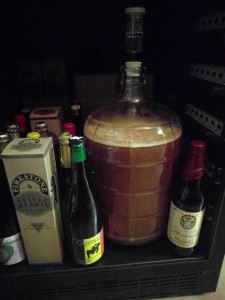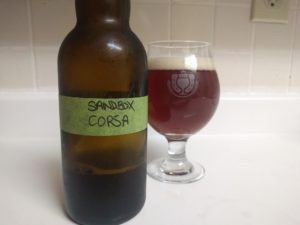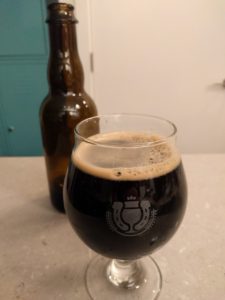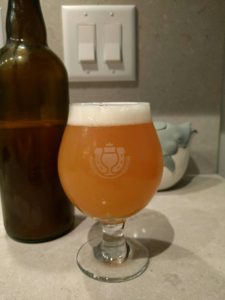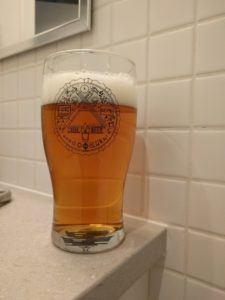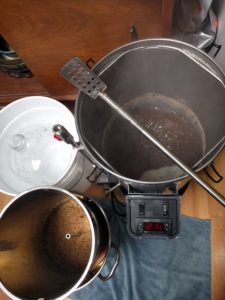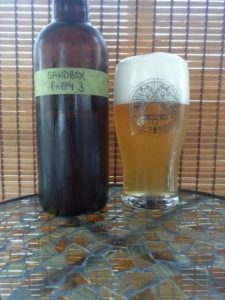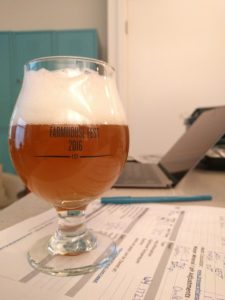Brewed: Jan 24, 2016 Bottled: Feb 20, 2016
Beer Style: Biere de Garde
OG: 1.071 FG: 1.009 IBU: 26 ABV: 8%
This was my first attempt at what I would like to be an annual tradition, the brewing of an ale inspired by the rustic French farmhouse ‘Biere de Garde’ ales from many years ago. That said, despite its old-world inspiration, it’s a bit of a modern departure. I used Munich as a base malt instead of pilsner to give it the deeper colour without having to boil all afternoon. I also added Caramunich in small quantity to provide a little further colour and malt complexity. Some simple sugar was added to assist the low mash temperature in reaching a low FG, as low as possible with the given yeast.
One of the drivers to wanting to brew this beer was the use of White Lab’s WLP515 Antwerp ale yeast. Although not a biére de garde yeast per se, its clean Belgian profile and good attenuation sounded perfect for the job. Its seasonal availability towards the end of the year is also appropriate for the traditionally winter-brewed style. I’ve hopped it at a slightly higher rate than traditional although still quite minimally, at about 26 IBU of Tettnang and Willamette.
Recipe (2.5 gallon batch):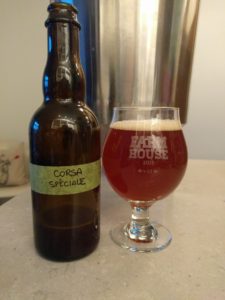
4.25 lbs Weyermann Munich I
2.50 lbs Weyermann Floor-malted Pilsner
0.35 lbs Weyermann Caramunich II
0.35 lbs Dextrose / Corn sugar
0.25 oz Willamette @ 60 min
0.25 oz Tettnang @ 60 min
0.25 oz Tettnang @ 15 min
WLP 515 – Antwerp Ale
Process
Infusion mashed at 145F for 45 minutes, increased to 152F for 45 minutes, mashed out 165F for 10 minutes (BIAB w. boiling water additions)
Boiled 120 minutes (stove-top)
Fermented 7 days at 65F, let rise to 72F for 14+ days. Ended up skipping the lagering phase until post-bottling.
Bottle conditioned with 2.7 volumes CO2 (corn sugar) – except 0.9 gallons went into a jug for secondary with port-soaked oak and brettanomyces.
Tasting Notes:
February 9th, 2016 – Pull off primary to check gravity. 1.009 (86.5% AA). Smells a little green still but tastes nice, good malt complexity. Just barely enough bitterness to balance which is what I was looking for. Compelling mix of sweet bread and grainy flavours.
March 1st, 2016 – No taste today, but pitched the dregs of a bottle of Goose Island Maltilda (Aug 2015 bottle) into the 0.9 gallons of “Corsa Specialé” in secondary.
March 5th, 2016 – First bottle. Didn’t wait as long as I intended but wanted to check on carbonation. Well, carb is coming along well and taste is better than I expected. Toasty bread with some plum-like fruitiness. The malts come across sweet, but the beer’s got a pretty dry finish. Hops are barely there but do enough to balance, I think. Very much on track with what I was going for so far.
Oct 16, 2016 – Sweetness sits just below cloying with plum and sugary bread dominating. Other than being pretty sweet this is on point, I think.
Dec 26, 2016 – Bottle of the Specialé. The brett character is nice, but I went a little overboard on the oak and the American oak doesn’t jive as well as French oak would have. Also, there is simply no head retention. But beyond that the flavours are quite interesting and the sweetness of the original has been cut nicely by the brett and tannins.
Photos:
During ‘sparge’ (BIAB dunked in 1.2 gallons at 173F)
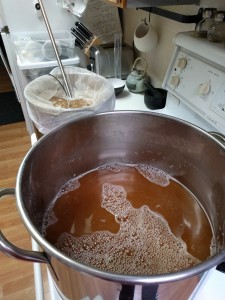
Put away for primary ferment:
